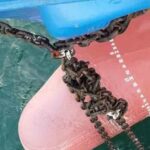Case Study: Scaffolding Comes Crashing Down; Two Victims Badly Injured
Scaffolding had been erected on top of hatch cover four of a general cargo vessel to allow two crewmembers to paint the crane jib while the vessel was underway. Seas were slight with no swell.
A permit to work had been issued and the generic risk assessment was considered. Both crew members were wearing personal protective equipment (PPE) and safety harnesses.
After they had completed painting the accessible parts of the jib, the two crew loosened the top securing rope, removed their safety
harnesses and started descending the scaffolding from opposite sides.

As they were climbing down the ship suddenly began rolling and the scaffolding tipped over, collapsing on the hatch cover and taking the two crew members with it.
The two victims were badly injured, and the vessel had to urgently deviate to evacuate them. One of them had to undergo surgery and both were subsequently repatriated under medical escort for further treatment in their home country.
The company investigation revealed that the accident occurred as a result of several substandard practices and conditions on board
including:
- Inadequate work planning/preparation. Not all of the risks associated with the assigned work had been considered, in particular the rapidity with which sea conditions can change, making scaffold work dangerous.
- Failure to ensure that the scaffolding was properly secured while the two crew members were descending. The top securing rope was loosened, making the scaffolding unstable while crew members were still on the scaffolding.
- Safety harnesses were not used while the two crew were descending the scaffolding.
- The two victims attempted to descend simultaneously. This may have made the scaffolding even more unstable if it was not done in a synchronised way.
Lessons learned
- Fall protection should be used in cases where a crew member is at risk of falling two metres or more. An approved safety harness including a fall arrestor, an inertia reel or a safety line should always be used, even when crew are ascending or descending, and should be connected to a strong point on the ship structure.
- Erecting scaffolding while the vessel is at sea can be dangerous as weather conditions can change rapidly.
- Scaffolding, when used, should be adequately secured from all sides and especially from the top.
- Generic risk assessments are often insufficient for many situations; they should always be task-specific.
Reference: nautinst.org
Do you have info to share with us ? Suggest a correction
About Author
Marine Insight News Network is a premier source for up-to-date, comprehensive, and insightful coverage of the maritime industry. Dedicated to offering the latest news, trends, and analyses in shipping, marine technology, regulations, and global maritime affairs, Marine Insight News Network prides itself on delivering accurate, engaging, and relevant information.

About Author
Marine Insight News Network is a premier source for up-to-date, comprehensive, and insightful coverage of the maritime industry. Dedicated to offering the latest news, trends, and analyses in shipping, marine technology, regulations, and global maritime affairs, Marine Insight News Network prides itself on delivering accurate, engaging, and relevant information.
- Real Life Incident: Vessel Collision in Good Visibility
- Real Life Incident: Severe Injury To Deck Crew While Leaving Berth
- Real Life Incident: Departure Damage in Very Restricted Waterway
- Real Life Incident: Low Situational Awareness Has High Impact Consequence
- Real Life Incident: Fouled Anchor in a Designated Anchorage
- Real Life Incident: Fire On Barge Carrying Scrap Metal Causes $7 Million Worth Of Damage
Latest Case studies Articles You Would Like:
Subscribe To Our Newsletters
By subscribing, you agree to our Privacy Policy and may receive occasional deal communications; you can unsubscribe anytime.
Web Stories




















